|
|
|
Sort Order |
|
|
|
Items / Page
|
|
|
|
|
|
|
| Srl | Item |
| 1 |
ID:
106499
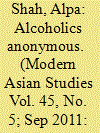

|
|
|
|
|
| Publication |
2011.
|
| Summary/Abstract |
From millenarian movements to the spread of Hindu rightwing militancy, attacks on adivasi (or tribal) consumption of alcohol have gone hand-in-hand with the project of 'civilizing the savage'. Emphasizing the agency and consciousness of adivasi political mobilization, subaltern studies scholarship has historically depicted adivasis as embracing and propelling these reformist measures, marking them as a challenge to the social structure. This paper examines these claims through an analysis of the relationship between alcohol and the spread of the Maoist insurgency in Jharkhand, Eastern India. Similar to other movements of adivasi political mobilization, an anti-drinking campaign is part of the Maoist spread in adivasi areas. This paper makes an argument for focusing on the internal diversity of adivasi political mobilization-in particular intergenerational and gender conflicts-emphasizing the differentiated social meanings of alcohol consumption (and thus of prohibition), as well as the very different attitudes taken by adivasis towards the Maoist campaign. The paper thus questions the binaries of 'sanskritisation' versus adivasis assertion that are prevalent in subaltern studies scholarship, proposing an engagement with adivasi internal politics that could reveal how adivasi political mobilization contains the penetrations of dominant sanskritic values, limitations to those penetrations and other aspirations, such as the desire for particular notions of modernity.
|
|
|
|
|
|
|
|
|
|
|
|
|
|
|
|
| 2 |
ID:
187283
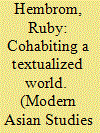

|
|
|
|
|
| Summary/Abstract |
Stories matter—writing them down matters. For indigenous (Adivasi) peoples from oral traditions, literature has become a way to maintain culture and keep it alive. This article too is a story—an investigative one—questioning and vocalizing the challenges we encounter in trying to articulate our realities and histories in a form that is new to us, one that we've been denied as a practice and one we are not believed we are entitled to use. Mainstream cultures have side-lined, overshadowed, and subjugated our knowledge systems, placing us in structures we have to traverse, and within which we have to exist, which is possible only by internalizing and mirroring others' or mainstream ways and languages to gain legitimacy as peoples or, worse, being branded and judged by their versions of narratives of us. This article plots the course of Adivasi histories and narratives enduring, outlasting, or being demolished by dislocation and dispossession, by dominant languages and cultures, and how both writing and orality are practices of both resistance and resurgence.
|
|
|
|
|
|
|
|
|
|
|
|
|
|
|
|
| 3 |
ID:
151141
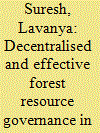

|
|
|
|
|
| Summary/Abstract |
Within the context of decentralised environmental governance, this article seeks to answer the question which institutional arrangements may be most effective in delivering the promise of better community-centred forest governance. The specific objective is to analyse the impact that decentralisation of resource management has on the effectiveness of forest governance. Using a comparative case study framework, the article finds that decentralisation functions better when nested structures with a plurality of bodies are in operation. However, the case studies also highlight the need for constant monitoring as a necessarily ongoing crucial process to protect the ecological sustainability of forest resource governance as well as strengthening equitable social structures at the village level.
|
|
|
|
|
|
|
|
|
|
|
|
|
|
|
|
| 4 |
ID:
121111
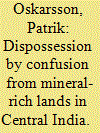

|
|
|
|
|
| Publication |
2013.
|
| Summary/Abstract |
Bauxite mineral projects in central India have in recent years generated conflicts over both the physical environment and equitable development for very vulnerable people. In one such project, a joint venture between the state government of Andhra Pradesh and a private investor, attempts are currently being made to open up land constitutionally reserved for India's Scheduled Tribes. The final outcome, though still uncertain, depends not only on the relative material resources of the opposing parties, but on a drawn-out process of contestation where the discursive resistance to tribal land dispossession has strong historical roots and many active supporters. Thus, for the project's promoters, their advantage rests on their ability to create confusion via superior access to, and control over, information, rather than relying on their direct authority.
|
|
|
|
|
|
|
|
|
|
|
|
|
|
|
|
| 5 |
ID:
157096
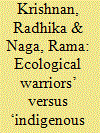

|
|
|
|
|
| Summary/Abstract |
This paper traces the nature of resistance in movements against land acquisition in Jagatsinghpur and Niyamgiri in the state of Odisha in India. At both sites, the movements were united in their opposition to the respective industrial projects, and to the state's notion of ‘development’ premised on resource extraction and large industry. At certain key junctures, the Niyamgiri resistance placed stress on the ‘sacred’ and the spiritual, while the resistance in Jagatsinghpur emphasised ‘traditional’ land- and water-based economic livelihoods. This paper uses these case studies to understand the role of overt and covert ‘performances’ of indigeneity in shaping environmental discourse as well as the state's response to resistance movements.
|
|
|
|
|
|
|
|
|
|
|
|
|
|
|
|
| 6 |
ID:
187287
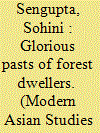

|
|
|
|
|
| Summary/Abstract |
This article discusses the shifts in rights over land of Binjhal Adivasi people in the wake of colonial rule in the ex-zamindari of Borasambar, located in the British Central Provinces in the eventful period from 1860–1926. Oral narratives and documents preserved by Binjhal villagers juxtaposed with archived records of military expeditions, village surveys, administrative letters, and land settlement reports reveal how Binjhal ancestors lost titled land and offices of headmanship, which, over time, impoverished and diminished them in the rural hierarchy. The research finds that the codification of selective custom as legal rights accommodated colonial land policies to promote social change and agricultural improvement. Environmental histories document how nineteenth-century forest enclosures and agrarian order brought Adivasi areas within state control. Revisionist research highlights historically contingent outcomes of colonial rule. The Adivasi pasts in this article reveal how the interpretations of legal culture by local actors, who transacted with the administration, led to variable outcomes for a pre-colonial land-controlling group. By examining the truth claims in fragments of Binjhal voices and narratives about them, in village memories and archives, through a threefold examination of the past—pragmatic, habitual, and episodic—this article explores the historicity of Adivasi land memories. Here, stories of past glory lead to claims of legal entitlements rather than restitution of ancient rule, and injustices are described in the idiom of disrupted kinship and transgressions of women, illuminating the varied routes through which groups residing in relatively non-agrarian upland habitats became Adivasi.
|
|
|
|
|
|
|
|
|
|
|
|
|
|
|
|
| 7 |
ID:
096924
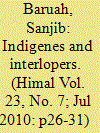

|
|
|
| 8 |
ID:
187279
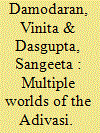

|
|
|
|
|
| Summary/Abstract |
On 6 December 1959, the image of Indian Prime Minister Jawaharlal Nehru inaugurating the Damodar Valley Corporation dam project in Bihar with a 15-year-old Adivasi girl called Budhini Manjhiyan was flashed across the national newspapers. This was an iconic moment in the national debate around development and change which was to dominate modern India on whether lands, predominately rural and tribal, were to be flooded to benefit the nation. Years later, in 2016, when the newspapers caught up with Budhini, she had returned to Jharkhand and was struggling to make ends meet for herself and her children. Her story resonates with the ways in which, in recent times, Adivasis are becoming increasingly visible as subjects in debates around indigeneity, identity, conversion, development, and climate change. The post-colonial Indian state and its allies, with a developmentalist agenda uppermost in their minds, have made loss of land, displacement, migration, and forced resettlement a part of Adivasi experiences. Forces of globalization, often in tandem with the policies of the Indian state, are engulfing marginal spaces. The increasingly powerful majoritarian narrative of the state subsumes alternate voices with easy nonchalance. The foregrounding of planetary narratives on the fate of humanity in the era of the Anthropocene erases the importance of particular locales and specific communities that could offer an alternative to declensionist narratives. But amid this marginalization, there also lies a story of the assertion of Adivasi agency. Voices of Adivasis—although multiple and fractured—can be heard as they assert their identity, express their politics, and creatively negotiate with the state and its institutions. Scattered across India in geographically differentiated terrains, pursuing different occupations, and speaking different languages, the experiences of Adivasis are varied, as they inhabit many worlds. Their stories point to the multiplicity of cultures and myriad ways of thinking that must be accommodated within the ambit of the nation, and yet offer the possibilities of different ways of living and being on this earth.
|
|
|
|
|
|
|
|
|
|
|
|
|
|
|
|
| 9 |
ID:
091729
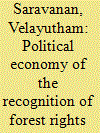

|
|
|
|
|
| Publication |
2009.
|
| Summary/Abstract |
Politics has played havoc with tribals and the environment during the post-Independence period in India. Even after fi fty years of Indian planning, deprived groups, and tribals in particular, continue to remain underdeveloped, with their living conditions deteriorating further. Taking a historical perspective, this article seeks to capture the political undercurrents of economic policy-making towards tribals and tribal development planning and specifi cally analyses the consequences of the Scheduled Tribes and Other Traditional Forest Dwellers (Recognition of Forest Rights) Act of 2006 on the environment as well as tribal development. Examining whether this new, politically motivated law will provide an impetus for economic progress of the tribals and environmental sustainability, it is argued that this Act will neither benefit the tribal communities nor enhance conservation. Rather, it serves as a cloak to justify non-tribal intervention, with potentially disastrous consequences.
|
|
|
|
|
|
|
|
|
|
|
|
|
|
|
|
| 10 |
ID:
084245
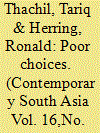

|
|
|
|
|
| Publication |
2008.
|
| Summary/Abstract |
The surprising loss of the Bharatiya Janata Party (BJP)-led national government in India's 2004 general elections has been generally understood as a rejection of the National Democratic Alliance's campaign that celebrated a 'Shining India' among voters who had not shared in the wealth produced by India's recent growth boom-especially Scheduled Caste and Scheduled Tribe electorates. A close look at the empirical evidence demonstrates that Dalit and Adivasi communities were by no means the homogeneous voting block portrayed in many post-election analyses. Nor did the BJP consistently lose in these constituencies. Both findings undermine the currently popular conceptualization of Indian electoral and party behavior as identity-based or ethnic. Instead, the 2004 results confirmed a growing trend for these disadvantaged populations to vote for radically dissimilar parties across different states-from the Communist Party of India (Marxist), to the Congress, to the Bahujan Samaj Party, or indeed to the BJP itself-driven by plausible calculation of interests. Using national election data from the 1999 and 2004 elections, this paper examines the theoretical puzzle this divergent electoral behavior presents to both the comparative literature on cleavage-based party systems and the scholarship on caste and identity politics in India. We argue that at least some of this variance can be explained by the fact that differences in state-level conditions influence which of the array of strategies used by Indian parties to recruit Dalit and Adivasi voters is likely to be successful. We then analyze the specific puzzle of differential BJP success among Adivasi/Dalit communities. We conclude that the embedded nature of the BJP as a party with social movement characteristics, combined with the poor developmental performance of many Indian states for their most disadvantaged populations, opens a spatially and politically differentiated niche for a social-provisioning electoral strategy. Developing this strategy has aided the BJP in overcoming at least partially its legacy as a Brahmin-Bania party.
|
|
|
|
|
|
|
|
|
|
|
|
|
|
|
|
| 11 |
ID:
176582
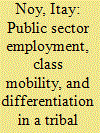

|
|
|
|
|
| Summary/Abstract |
India's adivasi, or tribal, communities have most often been depicted as homogeneous and egalitarian, at least compared to the entrenched social hierarchies that characterise rural caste society. This article draws on fieldwork in a mining-affected adivasi village in Jharkhand, eastern India, to consider how compensatory public sector employment for mining-induced land dispossession has contributed to new processes of stratification within adivasi society. On the one hand, compensatory employment allowed those who attained it to pursue increasingly common middle-class aspirations, and a considerable degree of class mobility. But on the other hand, it fostered new, enhanced forms of intra-adivasi differentiation – not only in terms of income but also consumption and lifestyle, education and children's life chances, and household and gender dynamics. New internal disparities, in turn, have acted to erode pre-existing elements of adivasi society that revolve around values of egalitarianism.
|
|
|
|
|
|
|
|
|
|
|
|
|
|
|
|
| 12 |
ID:
191063
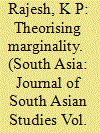

|
|
|
|
|
| Summary/Abstract |
Despite the accepted usage of ‘marginality’ as a subcategory of subalternity, seldom has the meaning of marginality as a concept been expounded. This paper sets out to address this lack by conceiving of ‘marginality’ as a condition, by focusing on the lived experiences of Adivasis in Kerala through the discourses constructed by a contemporary social movement, the Adivasi Gothra Maha Sabha (AGMS). Discourse analysis is the methodological frame that I have used in this paper to analyse the descriptions produced by the AGMS and the state of Kerala, and this is broadly situated within the post-colonial political-sociological approach. Premised on this, I argue that while marginality is an essential concept for looking at contemporary Adivasi movements in India, it is productive to interrogate and explore expanding the varied meanings attached to this concept.
|
|
|
|
|
|
|
|
|
|
|
|
|
|
|
|
|
|
|
|
|